Literature Review: Risky Play in Early Childhood Education
VerifiedAdded on 2022/10/06
|11
|3781
|21
Report
AI Summary
This report presents a comprehensive literature review on the topic of risky play in early childhood settings, focusing on the perceptions of adults and educators regarding its implementation and importance. The review synthesizes findings from several studies conducted in Australia, the United States, and Norway, examining educators' and parents' attitudes towards outdoor risky play and the factors influencing its provision. Key themes explored include the impact of regulatory environments, the benefits of risky play for child development (such as promoting physical skills, independence, and risk assessment), and the gaps in current research, particularly concerning parental perspectives. The review highlights the need for increased opportunities for risky play, such as sliding and gross motor activities, while also emphasizing the importance of balancing risk with safety. The report concludes by identifying gaps in the existing research and provides recommendations for future studies, particularly focusing on parental attitudes and the development of age-appropriate risky play activities. The research emphasizes the need for pre-service training for teachers and the need to balance safety with the benefits of risky play for children.
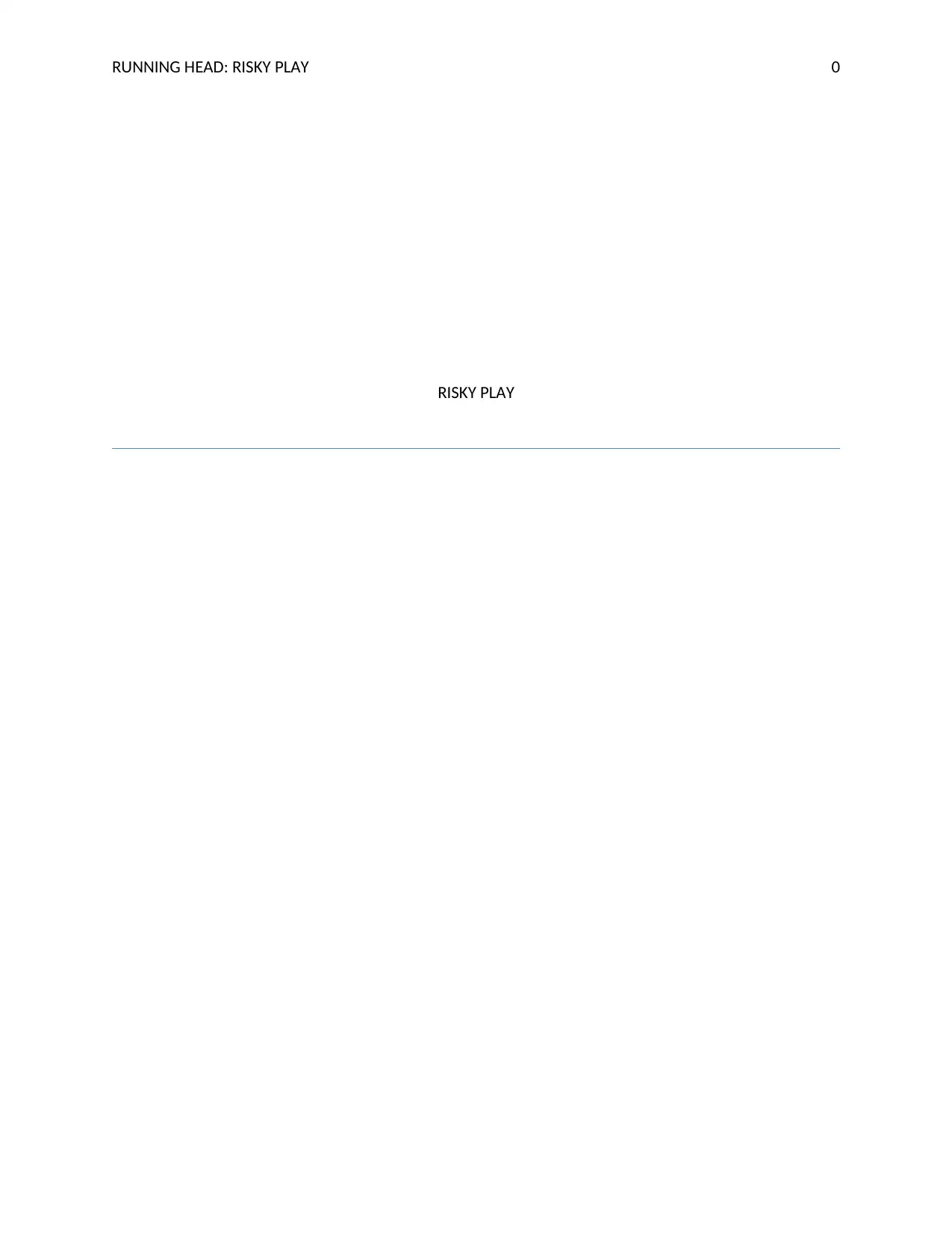
RUNNING HEAD: RISKY PLAY 0
RISKY PLAY
RISKY PLAY
Paraphrase This Document
Need a fresh take? Get an instant paraphrase of this document with our AI Paraphraser
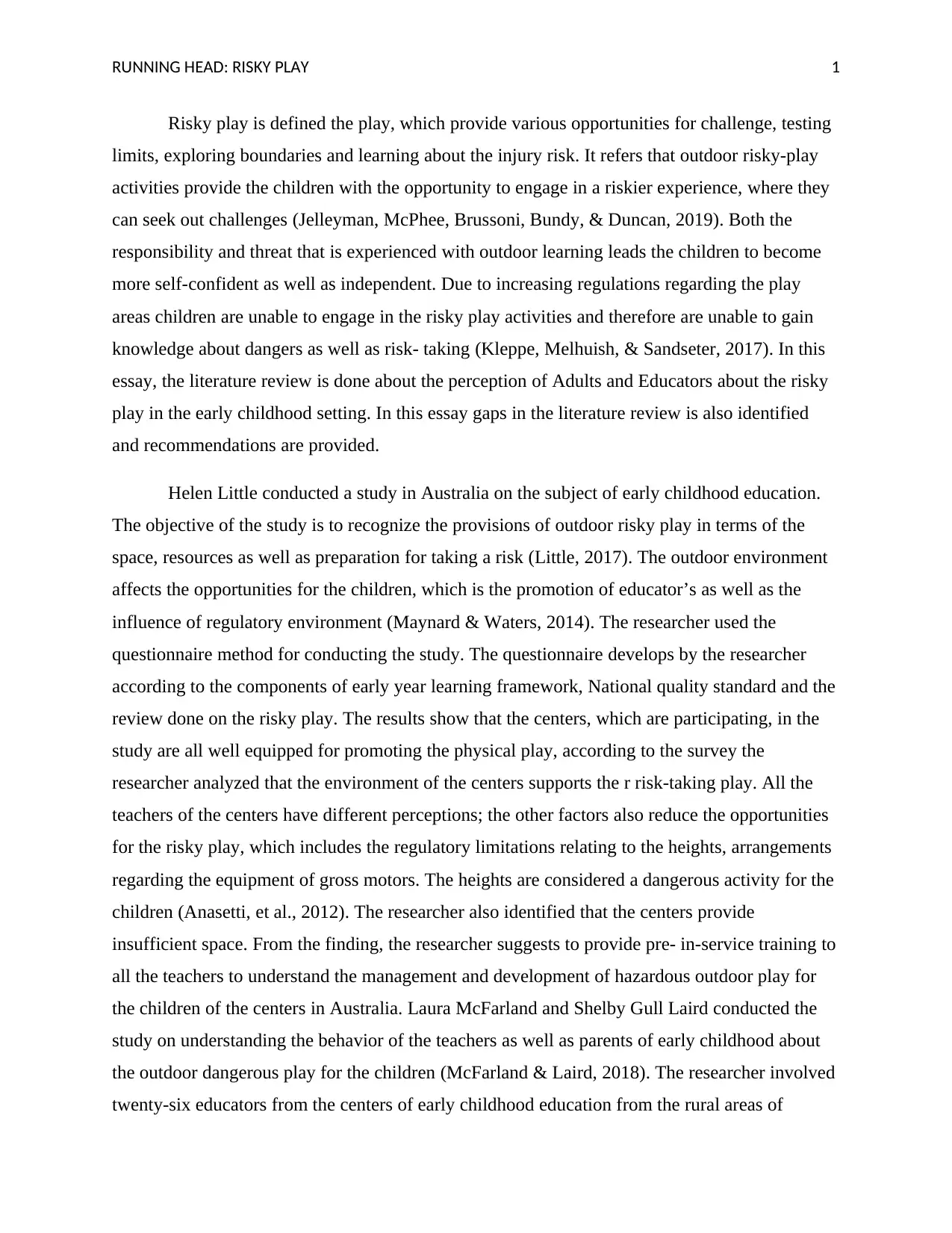
RUNNING HEAD: RISKY PLAY 1
Risky play is defined the play, which provide various opportunities for challenge, testing
limits, exploring boundaries and learning about the injury risk. It refers that outdoor risky-play
activities provide the children with the opportunity to engage in a riskier experience, where they
can seek out challenges (Jelleyman, McPhee, Brussoni, Bundy, & Duncan, 2019). Both the
responsibility and threat that is experienced with outdoor learning leads the children to become
more self-confident as well as independent. Due to increasing regulations regarding the play
areas children are unable to engage in the risky play activities and therefore are unable to gain
knowledge about dangers as well as risk- taking (Kleppe, Melhuish, & Sandseter, 2017). In this
essay, the literature review is done about the perception of Adults and Educators about the risky
play in the early childhood setting. In this essay gaps in the literature review is also identified
and recommendations are provided.
Helen Little conducted a study in Australia on the subject of early childhood education.
The objective of the study is to recognize the provisions of outdoor risky play in terms of the
space, resources as well as preparation for taking a risk (Little, 2017). The outdoor environment
affects the opportunities for the children, which is the promotion of educator’s as well as the
influence of regulatory environment (Maynard & Waters, 2014). The researcher used the
questionnaire method for conducting the study. The questionnaire develops by the researcher
according to the components of early year learning framework, National quality standard and the
review done on the risky play. The results show that the centers, which are participating, in the
study are all well equipped for promoting the physical play, according to the survey the
researcher analyzed that the environment of the centers supports the r risk-taking play. All the
teachers of the centers have different perceptions; the other factors also reduce the opportunities
for the risky play, which includes the regulatory limitations relating to the heights, arrangements
regarding the equipment of gross motors. The heights are considered a dangerous activity for the
children (Anasetti, et al., 2012). The researcher also identified that the centers provide
insufficient space. From the finding, the researcher suggests to provide pre- in-service training to
all the teachers to understand the management and development of hazardous outdoor play for
the children of the centers in Australia. Laura McFarland and Shelby Gull Laird conducted the
study on understanding the behavior of the teachers as well as parents of early childhood about
the outdoor dangerous play for the children (McFarland & Laird, 2018). The researcher involved
twenty-six educators from the centers of early childhood education from the rural areas of
Risky play is defined the play, which provide various opportunities for challenge, testing
limits, exploring boundaries and learning about the injury risk. It refers that outdoor risky-play
activities provide the children with the opportunity to engage in a riskier experience, where they
can seek out challenges (Jelleyman, McPhee, Brussoni, Bundy, & Duncan, 2019). Both the
responsibility and threat that is experienced with outdoor learning leads the children to become
more self-confident as well as independent. Due to increasing regulations regarding the play
areas children are unable to engage in the risky play activities and therefore are unable to gain
knowledge about dangers as well as risk- taking (Kleppe, Melhuish, & Sandseter, 2017). In this
essay, the literature review is done about the perception of Adults and Educators about the risky
play in the early childhood setting. In this essay gaps in the literature review is also identified
and recommendations are provided.
Helen Little conducted a study in Australia on the subject of early childhood education.
The objective of the study is to recognize the provisions of outdoor risky play in terms of the
space, resources as well as preparation for taking a risk (Little, 2017). The outdoor environment
affects the opportunities for the children, which is the promotion of educator’s as well as the
influence of regulatory environment (Maynard & Waters, 2014). The researcher used the
questionnaire method for conducting the study. The questionnaire develops by the researcher
according to the components of early year learning framework, National quality standard and the
review done on the risky play. The results show that the centers, which are participating, in the
study are all well equipped for promoting the physical play, according to the survey the
researcher analyzed that the environment of the centers supports the r risk-taking play. All the
teachers of the centers have different perceptions; the other factors also reduce the opportunities
for the risky play, which includes the regulatory limitations relating to the heights, arrangements
regarding the equipment of gross motors. The heights are considered a dangerous activity for the
children (Anasetti, et al., 2012). The researcher also identified that the centers provide
insufficient space. From the finding, the researcher suggests to provide pre- in-service training to
all the teachers to understand the management and development of hazardous outdoor play for
the children of the centers in Australia. Laura McFarland and Shelby Gull Laird conducted the
study on understanding the behavior of the teachers as well as parents of early childhood about
the outdoor dangerous play for the children (McFarland & Laird, 2018). The researcher involved
twenty-six educators from the centers of early childhood education from the rural areas of
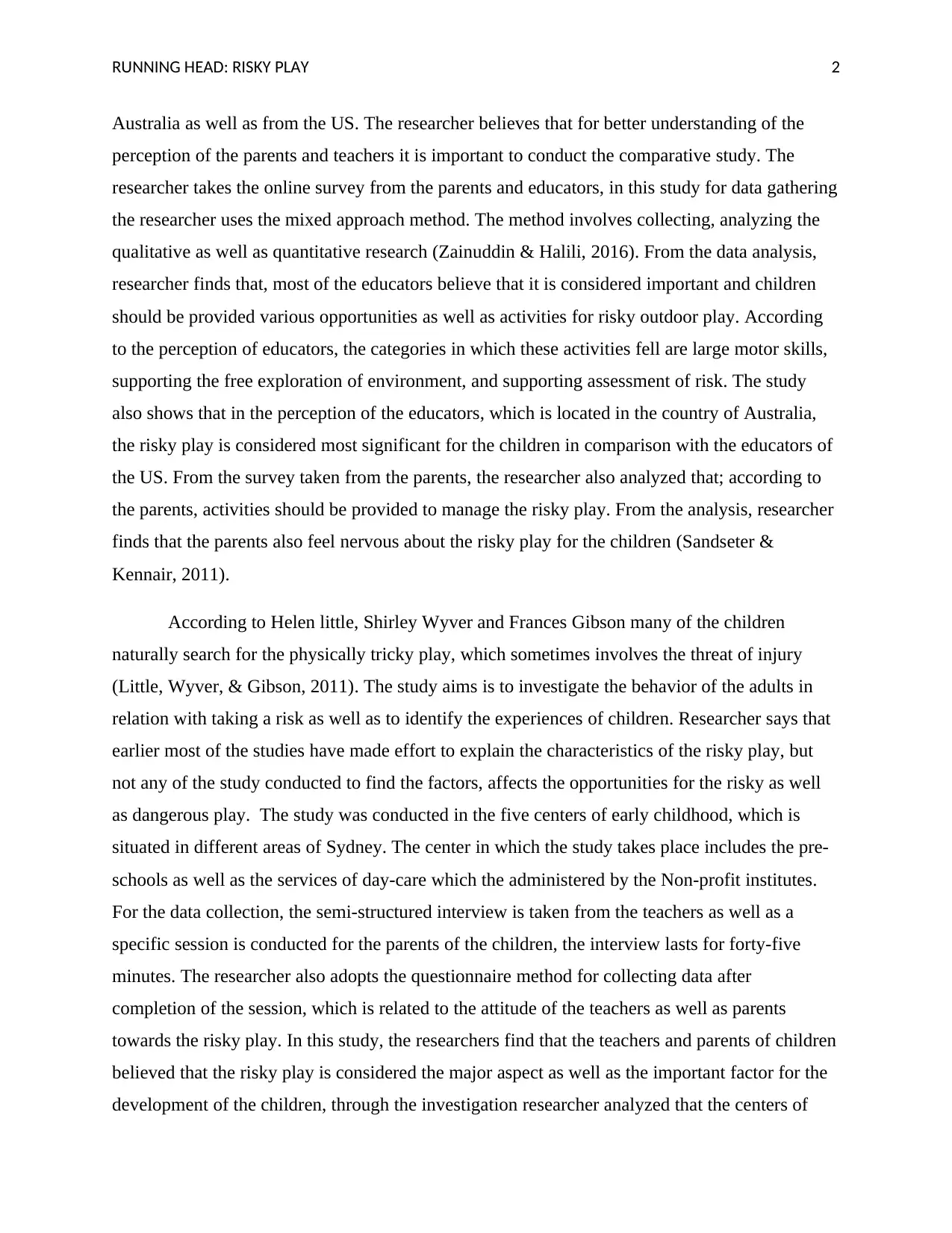
RUNNING HEAD: RISKY PLAY 2
Australia as well as from the US. The researcher believes that for better understanding of the
perception of the parents and teachers it is important to conduct the comparative study. The
researcher takes the online survey from the parents and educators, in this study for data gathering
the researcher uses the mixed approach method. The method involves collecting, analyzing the
qualitative as well as quantitative research (Zainuddin & Halili, 2016). From the data analysis,
researcher finds that, most of the educators believe that it is considered important and children
should be provided various opportunities as well as activities for risky outdoor play. According
to the perception of educators, the categories in which these activities fell are large motor skills,
supporting the free exploration of environment, and supporting assessment of risk. The study
also shows that in the perception of the educators, which is located in the country of Australia,
the risky play is considered most significant for the children in comparison with the educators of
the US. From the survey taken from the parents, the researcher also analyzed that; according to
the parents, activities should be provided to manage the risky play. From the analysis, researcher
finds that the parents also feel nervous about the risky play for the children (Sandseter &
Kennair, 2011).
According to Helen little, Shirley Wyver and Frances Gibson many of the children
naturally search for the physically tricky play, which sometimes involves the threat of injury
(Little, Wyver, & Gibson, 2011). The study aims is to investigate the behavior of the adults in
relation with taking a risk as well as to identify the experiences of children. Researcher says that
earlier most of the studies have made effort to explain the characteristics of the risky play, but
not any of the study conducted to find the factors, affects the opportunities for the risky as well
as dangerous play. The study was conducted in the five centers of early childhood, which is
situated in different areas of Sydney. The center in which the study takes place includes the pre-
schools as well as the services of day-care which the administered by the Non-profit institutes.
For the data collection, the semi-structured interview is taken from the teachers as well as a
specific session is conducted for the parents of the children, the interview lasts for forty-five
minutes. The researcher also adopts the questionnaire method for collecting data after
completion of the session, which is related to the attitude of the teachers as well as parents
towards the risky play. In this study, the researchers find that the teachers and parents of children
believed that the risky play is considered the major aspect as well as the important factor for the
development of the children, through the investigation researcher analyzed that the centers of
Australia as well as from the US. The researcher believes that for better understanding of the
perception of the parents and teachers it is important to conduct the comparative study. The
researcher takes the online survey from the parents and educators, in this study for data gathering
the researcher uses the mixed approach method. The method involves collecting, analyzing the
qualitative as well as quantitative research (Zainuddin & Halili, 2016). From the data analysis,
researcher finds that, most of the educators believe that it is considered important and children
should be provided various opportunities as well as activities for risky outdoor play. According
to the perception of educators, the categories in which these activities fell are large motor skills,
supporting the free exploration of environment, and supporting assessment of risk. The study
also shows that in the perception of the educators, which is located in the country of Australia,
the risky play is considered most significant for the children in comparison with the educators of
the US. From the survey taken from the parents, the researcher also analyzed that; according to
the parents, activities should be provided to manage the risky play. From the analysis, researcher
finds that the parents also feel nervous about the risky play for the children (Sandseter &
Kennair, 2011).
According to Helen little, Shirley Wyver and Frances Gibson many of the children
naturally search for the physically tricky play, which sometimes involves the threat of injury
(Little, Wyver, & Gibson, 2011). The study aims is to investigate the behavior of the adults in
relation with taking a risk as well as to identify the experiences of children. Researcher says that
earlier most of the studies have made effort to explain the characteristics of the risky play, but
not any of the study conducted to find the factors, affects the opportunities for the risky as well
as dangerous play. The study was conducted in the five centers of early childhood, which is
situated in different areas of Sydney. The center in which the study takes place includes the pre-
schools as well as the services of day-care which the administered by the Non-profit institutes.
For the data collection, the semi-structured interview is taken from the teachers as well as a
specific session is conducted for the parents of the children, the interview lasts for forty-five
minutes. The researcher also adopts the questionnaire method for collecting data after
completion of the session, which is related to the attitude of the teachers as well as parents
towards the risky play. In this study, the researchers find that the teachers and parents of children
believed that the risky play is considered the major aspect as well as the important factor for the
development of the children, through the investigation researcher analyzed that the centers of
⊘ This is a preview!⊘
Do you want full access?
Subscribe today to unlock all pages.

Trusted by 1+ million students worldwide
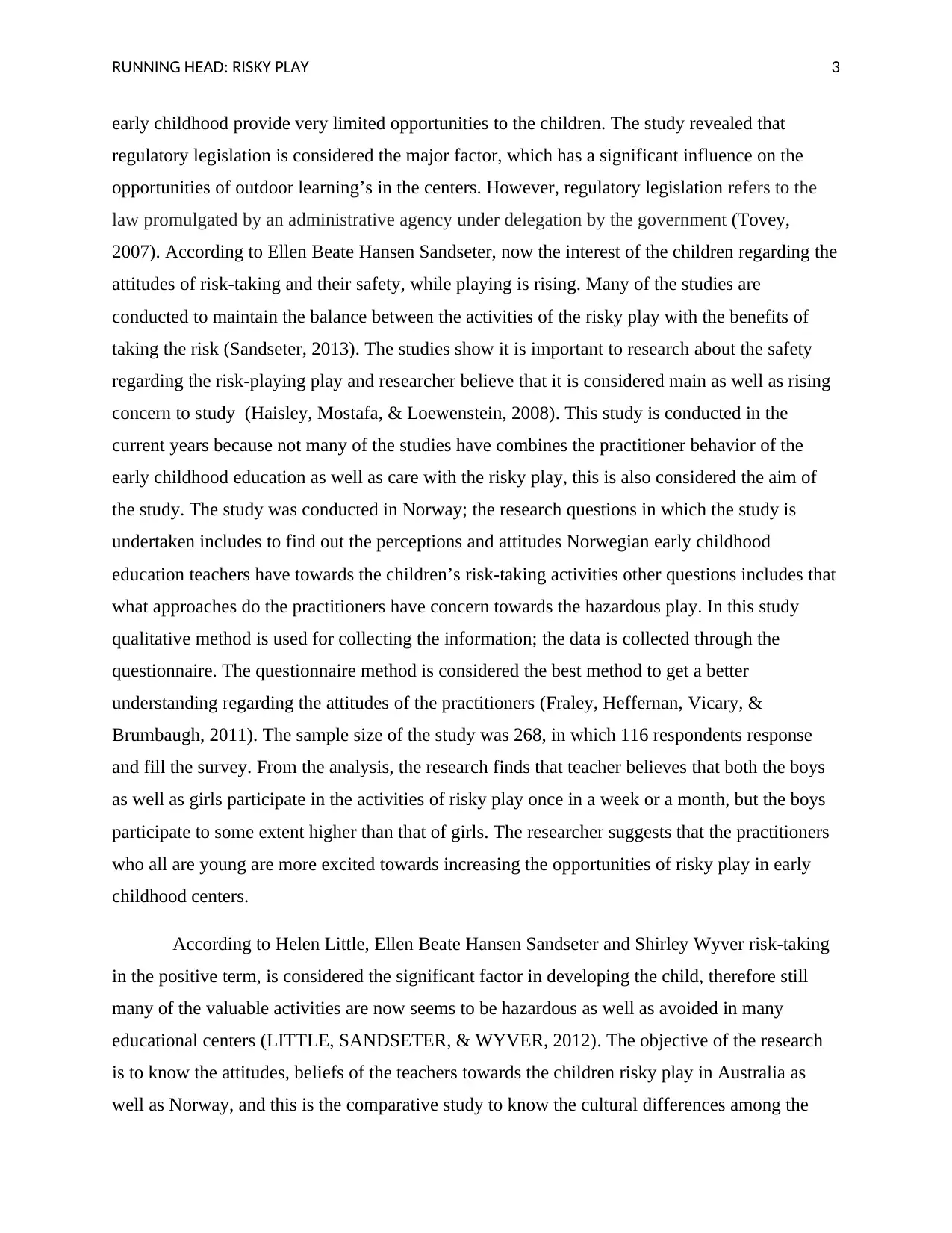
RUNNING HEAD: RISKY PLAY 3
early childhood provide very limited opportunities to the children. The study revealed that
regulatory legislation is considered the major factor, which has a significant influence on the
opportunities of outdoor learning’s in the centers. However, regulatory legislation refers to the
law promulgated by an administrative agency under delegation by the government (Tovey,
2007). According to Ellen Beate Hansen Sandseter, now the interest of the children regarding the
attitudes of risk-taking and their safety, while playing is rising. Many of the studies are
conducted to maintain the balance between the activities of the risky play with the benefits of
taking the risk (Sandseter, 2013). The studies show it is important to research about the safety
regarding the risk-playing play and researcher believe that it is considered main as well as rising
concern to study (Haisley, Mostafa, & Loewenstein, 2008). This study is conducted in the
current years because not many of the studies have combines the practitioner behavior of the
early childhood education as well as care with the risky play, this is also considered the aim of
the study. The study was conducted in Norway; the research questions in which the study is
undertaken includes to find out the perceptions and attitudes Norwegian early childhood
education teachers have towards the children’s risk-taking activities other questions includes that
what approaches do the practitioners have concern towards the hazardous play. In this study
qualitative method is used for collecting the information; the data is collected through the
questionnaire. The questionnaire method is considered the best method to get a better
understanding regarding the attitudes of the practitioners (Fraley, Heffernan, Vicary, &
Brumbaugh, 2011). The sample size of the study was 268, in which 116 respondents response
and fill the survey. From the analysis, the research finds that teacher believes that both the boys
as well as girls participate in the activities of risky play once in a week or a month, but the boys
participate to some extent higher than that of girls. The researcher suggests that the practitioners
who all are young are more excited towards increasing the opportunities of risky play in early
childhood centers.
According to Helen Little, Ellen Beate Hansen Sandseter and Shirley Wyver risk-taking
in the positive term, is considered the significant factor in developing the child, therefore still
many of the valuable activities are now seems to be hazardous as well as avoided in many
educational centers (LITTLE, SANDSETER, & WYVER, 2012). The objective of the research
is to know the attitudes, beliefs of the teachers towards the children risky play in Australia as
well as Norway, and this is the comparative study to know the cultural differences among the
early childhood provide very limited opportunities to the children. The study revealed that
regulatory legislation is considered the major factor, which has a significant influence on the
opportunities of outdoor learning’s in the centers. However, regulatory legislation refers to the
law promulgated by an administrative agency under delegation by the government (Tovey,
2007). According to Ellen Beate Hansen Sandseter, now the interest of the children regarding the
attitudes of risk-taking and their safety, while playing is rising. Many of the studies are
conducted to maintain the balance between the activities of the risky play with the benefits of
taking the risk (Sandseter, 2013). The studies show it is important to research about the safety
regarding the risk-playing play and researcher believe that it is considered main as well as rising
concern to study (Haisley, Mostafa, & Loewenstein, 2008). This study is conducted in the
current years because not many of the studies have combines the practitioner behavior of the
early childhood education as well as care with the risky play, this is also considered the aim of
the study. The study was conducted in Norway; the research questions in which the study is
undertaken includes to find out the perceptions and attitudes Norwegian early childhood
education teachers have towards the children’s risk-taking activities other questions includes that
what approaches do the practitioners have concern towards the hazardous play. In this study
qualitative method is used for collecting the information; the data is collected through the
questionnaire. The questionnaire method is considered the best method to get a better
understanding regarding the attitudes of the practitioners (Fraley, Heffernan, Vicary, &
Brumbaugh, 2011). The sample size of the study was 268, in which 116 respondents response
and fill the survey. From the analysis, the research finds that teacher believes that both the boys
as well as girls participate in the activities of risky play once in a week or a month, but the boys
participate to some extent higher than that of girls. The researcher suggests that the practitioners
who all are young are more excited towards increasing the opportunities of risky play in early
childhood centers.
According to Helen Little, Ellen Beate Hansen Sandseter and Shirley Wyver risk-taking
in the positive term, is considered the significant factor in developing the child, therefore still
many of the valuable activities are now seems to be hazardous as well as avoided in many
educational centers (LITTLE, SANDSETER, & WYVER, 2012). The objective of the research
is to know the attitudes, beliefs of the teachers towards the children risky play in Australia as
well as Norway, and this is the comparative study to know the cultural differences among the
Paraphrase This Document
Need a fresh take? Get an instant paraphrase of this document with our AI Paraphraser
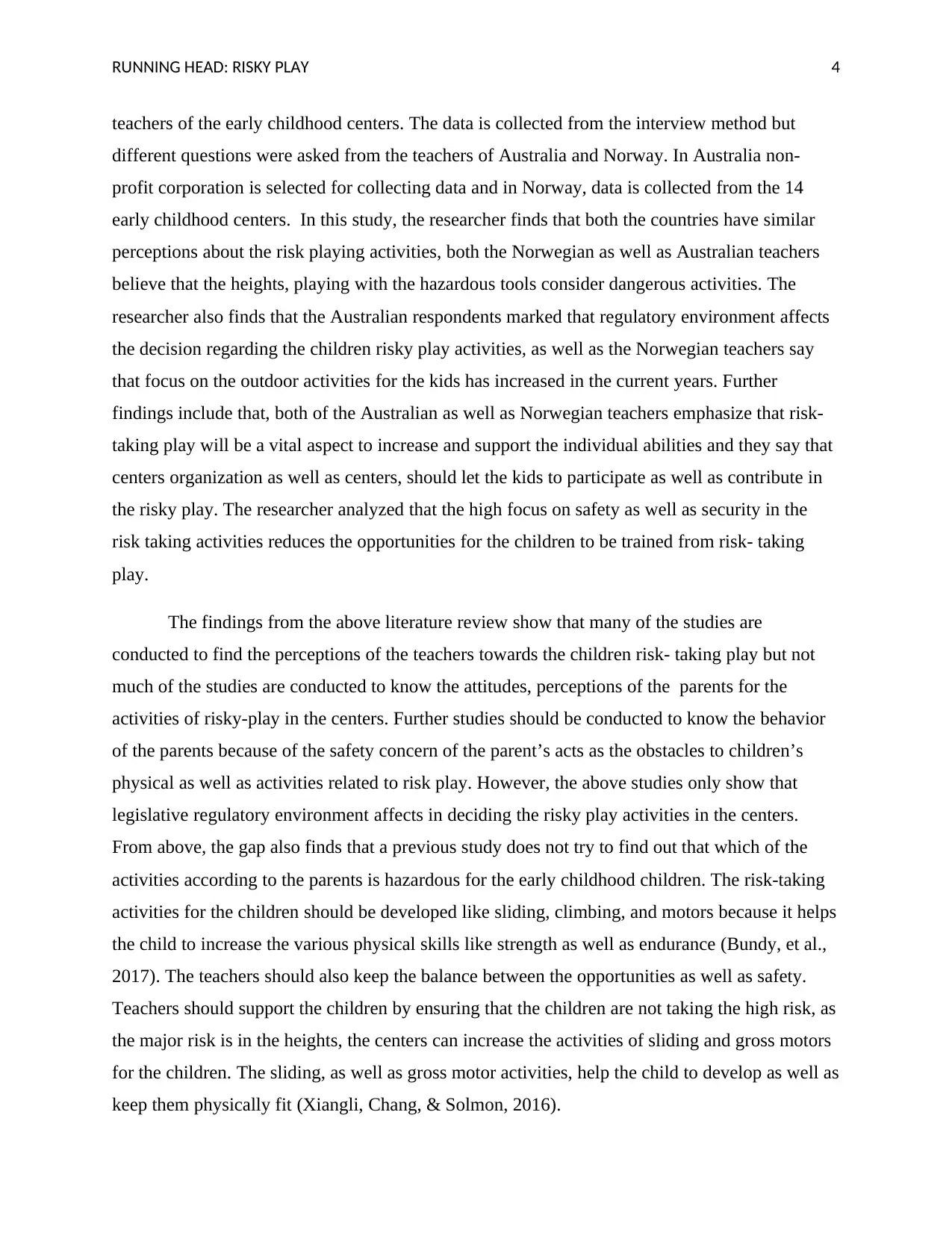
RUNNING HEAD: RISKY PLAY 4
teachers of the early childhood centers. The data is collected from the interview method but
different questions were asked from the teachers of Australia and Norway. In Australia non-
profit corporation is selected for collecting data and in Norway, data is collected from the 14
early childhood centers. In this study, the researcher finds that both the countries have similar
perceptions about the risk playing activities, both the Norwegian as well as Australian teachers
believe that the heights, playing with the hazardous tools consider dangerous activities. The
researcher also finds that the Australian respondents marked that regulatory environment affects
the decision regarding the children risky play activities, as well as the Norwegian teachers say
that focus on the outdoor activities for the kids has increased in the current years. Further
findings include that, both of the Australian as well as Norwegian teachers emphasize that risk-
taking play will be a vital aspect to increase and support the individual abilities and they say that
centers organization as well as centers, should let the kids to participate as well as contribute in
the risky play. The researcher analyzed that the high focus on safety as well as security in the
risk taking activities reduces the opportunities for the children to be trained from risk- taking
play.
The findings from the above literature review show that many of the studies are
conducted to find the perceptions of the teachers towards the children risk- taking play but not
much of the studies are conducted to know the attitudes, perceptions of the parents for the
activities of risky-play in the centers. Further studies should be conducted to know the behavior
of the parents because of the safety concern of the parent’s acts as the obstacles to children’s
physical as well as activities related to risk play. However, the above studies only show that
legislative regulatory environment affects in deciding the risky play activities in the centers.
From above, the gap also finds that a previous study does not try to find out that which of the
activities according to the parents is hazardous for the early childhood children. The risk-taking
activities for the children should be developed like sliding, climbing, and motors because it helps
the child to increase the various physical skills like strength as well as endurance (Bundy, et al.,
2017). The teachers should also keep the balance between the opportunities as well as safety.
Teachers should support the children by ensuring that the children are not taking the high risk, as
the major risk is in the heights, the centers can increase the activities of sliding and gross motors
for the children. The sliding, as well as gross motor activities, help the child to develop as well as
keep them physically fit (Xiangli, Chang, & Solmon, 2016).
teachers of the early childhood centers. The data is collected from the interview method but
different questions were asked from the teachers of Australia and Norway. In Australia non-
profit corporation is selected for collecting data and in Norway, data is collected from the 14
early childhood centers. In this study, the researcher finds that both the countries have similar
perceptions about the risk playing activities, both the Norwegian as well as Australian teachers
believe that the heights, playing with the hazardous tools consider dangerous activities. The
researcher also finds that the Australian respondents marked that regulatory environment affects
the decision regarding the children risky play activities, as well as the Norwegian teachers say
that focus on the outdoor activities for the kids has increased in the current years. Further
findings include that, both of the Australian as well as Norwegian teachers emphasize that risk-
taking play will be a vital aspect to increase and support the individual abilities and they say that
centers organization as well as centers, should let the kids to participate as well as contribute in
the risky play. The researcher analyzed that the high focus on safety as well as security in the
risk taking activities reduces the opportunities for the children to be trained from risk- taking
play.
The findings from the above literature review show that many of the studies are
conducted to find the perceptions of the teachers towards the children risk- taking play but not
much of the studies are conducted to know the attitudes, perceptions of the parents for the
activities of risky-play in the centers. Further studies should be conducted to know the behavior
of the parents because of the safety concern of the parent’s acts as the obstacles to children’s
physical as well as activities related to risk play. However, the above studies only show that
legislative regulatory environment affects in deciding the risky play activities in the centers.
From above, the gap also finds that a previous study does not try to find out that which of the
activities according to the parents is hazardous for the early childhood children. The risk-taking
activities for the children should be developed like sliding, climbing, and motors because it helps
the child to increase the various physical skills like strength as well as endurance (Bundy, et al.,
2017). The teachers should also keep the balance between the opportunities as well as safety.
Teachers should support the children by ensuring that the children are not taking the high risk, as
the major risk is in the heights, the centers can increase the activities of sliding and gross motors
for the children. The sliding, as well as gross motor activities, help the child to develop as well as
keep them physically fit (Xiangli, Chang, & Solmon, 2016).
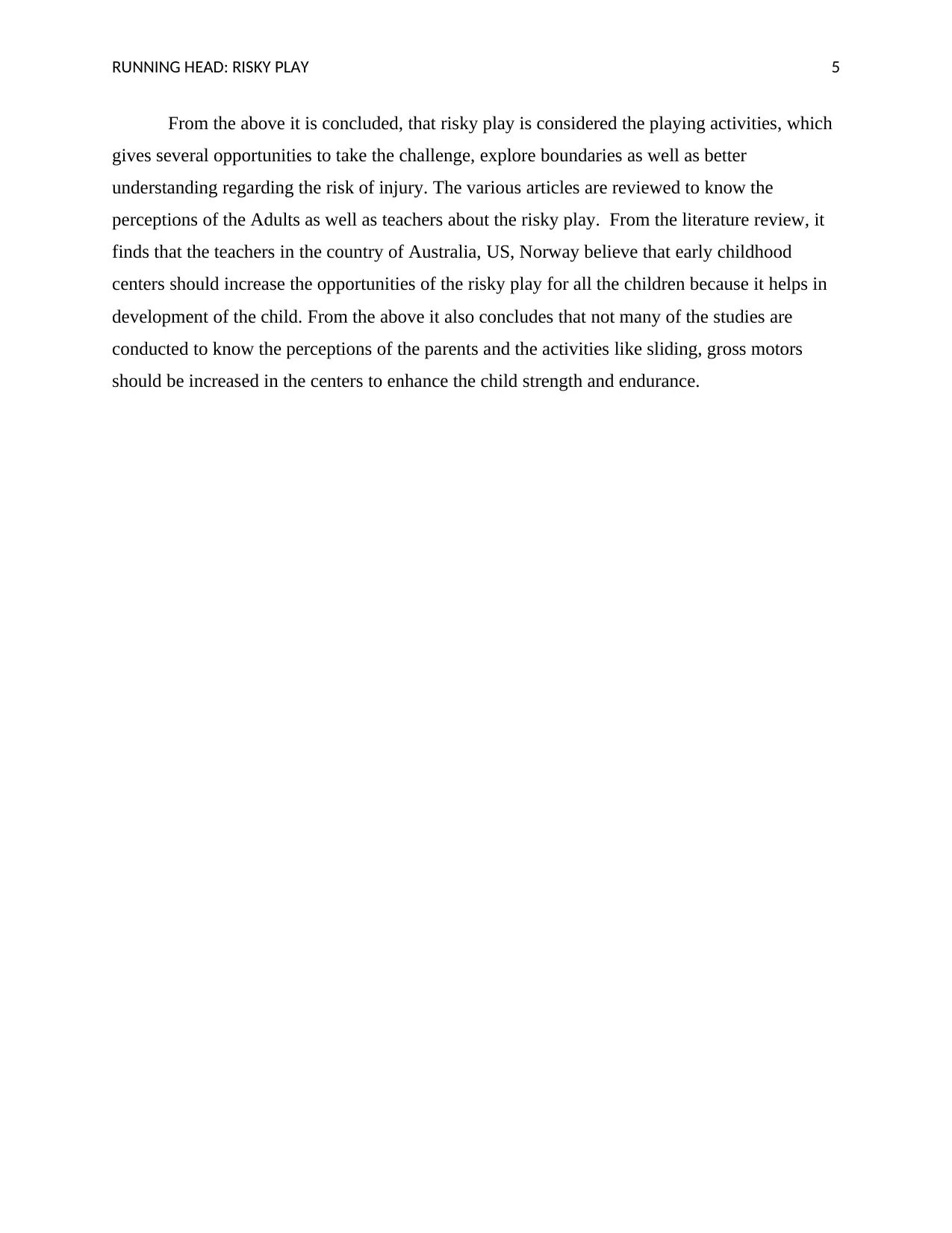
RUNNING HEAD: RISKY PLAY 5
From the above it is concluded, that risky play is considered the playing activities, which
gives several opportunities to take the challenge, explore boundaries as well as better
understanding regarding the risk of injury. The various articles are reviewed to know the
perceptions of the Adults as well as teachers about the risky play. From the literature review, it
finds that the teachers in the country of Australia, US, Norway believe that early childhood
centers should increase the opportunities of the risky play for all the children because it helps in
development of the child. From the above it also concludes that not many of the studies are
conducted to know the perceptions of the parents and the activities like sliding, gross motors
should be increased in the centers to enhance the child strength and endurance.
From the above it is concluded, that risky play is considered the playing activities, which
gives several opportunities to take the challenge, explore boundaries as well as better
understanding regarding the risk of injury. The various articles are reviewed to know the
perceptions of the Adults as well as teachers about the risky play. From the literature review, it
finds that the teachers in the country of Australia, US, Norway believe that early childhood
centers should increase the opportunities of the risky play for all the children because it helps in
development of the child. From the above it also concludes that not many of the studies are
conducted to know the perceptions of the parents and the activities like sliding, gross motors
should be increased in the centers to enhance the child strength and endurance.
⊘ This is a preview!⊘
Do you want full access?
Subscribe today to unlock all pages.

Trusted by 1+ million students worldwide
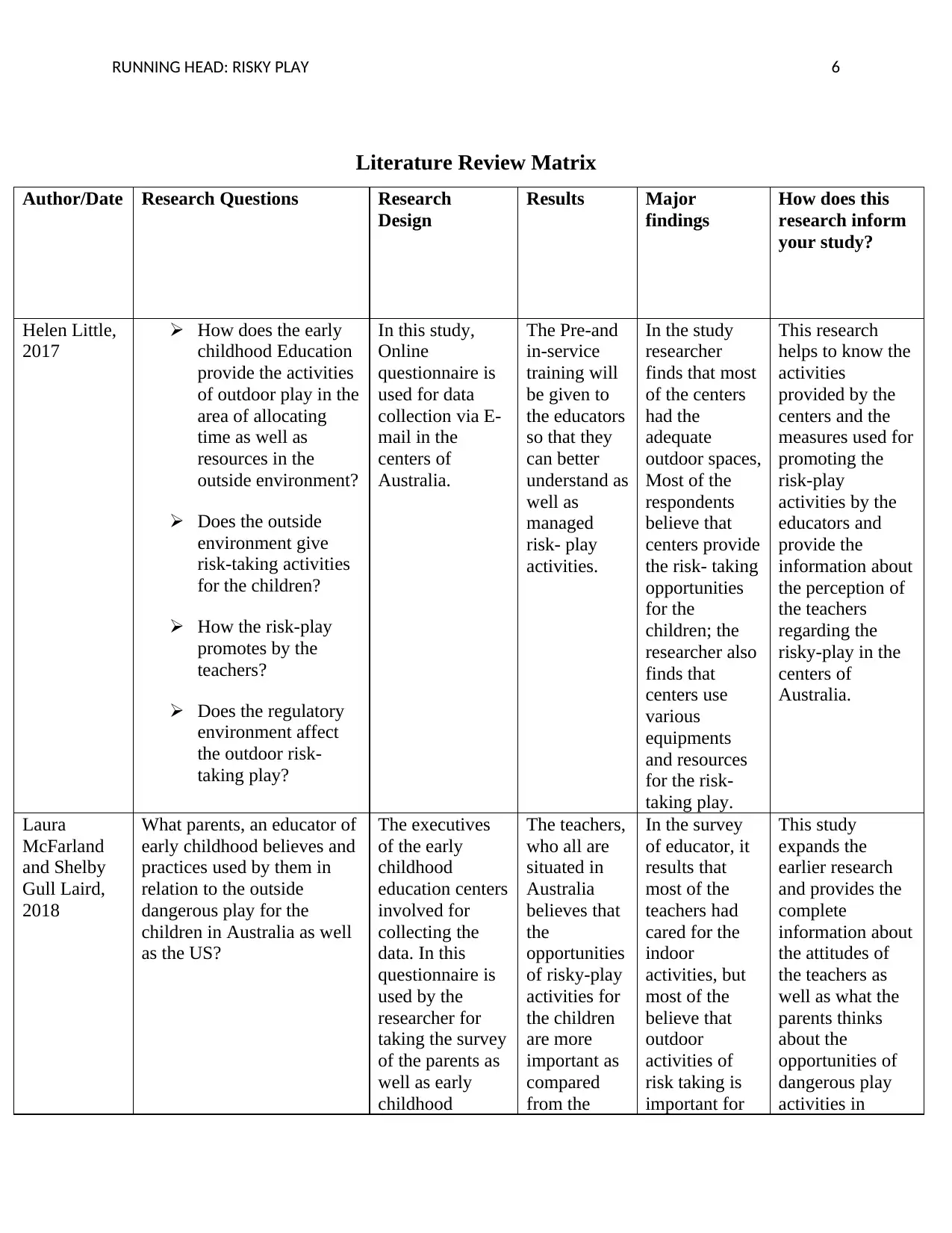
RUNNING HEAD: RISKY PLAY 6
Literature Review Matrix
Author/Date Research Questions Research
Design
Results Major
findings
How does this
research inform
your study?
Helen Little,
2017
How does the early
childhood Education
provide the activities
of outdoor play in the
area of allocating
time as well as
resources in the
outside environment?
Does the outside
environment give
risk-taking activities
for the children?
How the risk-play
promotes by the
teachers?
Does the regulatory
environment affect
the outdoor risk-
taking play?
In this study,
Online
questionnaire is
used for data
collection via E-
mail in the
centers of
Australia.
The Pre-and
in-service
training will
be given to
the educators
so that they
can better
understand as
well as
managed
risk- play
activities.
In the study
researcher
finds that most
of the centers
had the
adequate
outdoor spaces,
Most of the
respondents
believe that
centers provide
the risk- taking
opportunities
for the
children; the
researcher also
finds that
centers use
various
equipments
and resources
for the risk-
taking play.
This research
helps to know the
activities
provided by the
centers and the
measures used for
promoting the
risk-play
activities by the
educators and
provide the
information about
the perception of
the teachers
regarding the
risky-play in the
centers of
Australia.
Laura
McFarland
and Shelby
Gull Laird,
2018
What parents, an educator of
early childhood believes and
practices used by them in
relation to the outside
dangerous play for the
children in Australia as well
as the US?
The executives
of the early
childhood
education centers
involved for
collecting the
data. In this
questionnaire is
used by the
researcher for
taking the survey
of the parents as
well as early
childhood
The teachers,
who all are
situated in
Australia
believes that
the
opportunities
of risky-play
activities for
the children
are more
important as
compared
from the
In the survey
of educator, it
results that
most of the
teachers had
cared for the
indoor
activities, but
most of the
believe that
outdoor
activities of
risk taking is
important for
This study
expands the
earlier research
and provides the
complete
information about
the attitudes of
the teachers as
well as what the
parents thinks
about the
opportunities of
dangerous play
activities in
Literature Review Matrix
Author/Date Research Questions Research
Design
Results Major
findings
How does this
research inform
your study?
Helen Little,
2017
How does the early
childhood Education
provide the activities
of outdoor play in the
area of allocating
time as well as
resources in the
outside environment?
Does the outside
environment give
risk-taking activities
for the children?
How the risk-play
promotes by the
teachers?
Does the regulatory
environment affect
the outdoor risk-
taking play?
In this study,
Online
questionnaire is
used for data
collection via E-
mail in the
centers of
Australia.
The Pre-and
in-service
training will
be given to
the educators
so that they
can better
understand as
well as
managed
risk- play
activities.
In the study
researcher
finds that most
of the centers
had the
adequate
outdoor spaces,
Most of the
respondents
believe that
centers provide
the risk- taking
opportunities
for the
children; the
researcher also
finds that
centers use
various
equipments
and resources
for the risk-
taking play.
This research
helps to know the
activities
provided by the
centers and the
measures used for
promoting the
risk-play
activities by the
educators and
provide the
information about
the perception of
the teachers
regarding the
risky-play in the
centers of
Australia.
Laura
McFarland
and Shelby
Gull Laird,
2018
What parents, an educator of
early childhood believes and
practices used by them in
relation to the outside
dangerous play for the
children in Australia as well
as the US?
The executives
of the early
childhood
education centers
involved for
collecting the
data. In this
questionnaire is
used by the
researcher for
taking the survey
of the parents as
well as early
childhood
The teachers,
who all are
situated in
Australia
believes that
the
opportunities
of risky-play
activities for
the children
are more
important as
compared
from the
In the survey
of educator, it
results that
most of the
teachers had
cared for the
indoor
activities, but
most of the
believe that
outdoor
activities of
risk taking is
important for
This study
expands the
earlier research
and provides the
complete
information about
the attitudes of
the teachers as
well as what the
parents thinks
about the
opportunities of
dangerous play
activities in
Paraphrase This Document
Need a fresh take? Get an instant paraphrase of this document with our AI Paraphraser
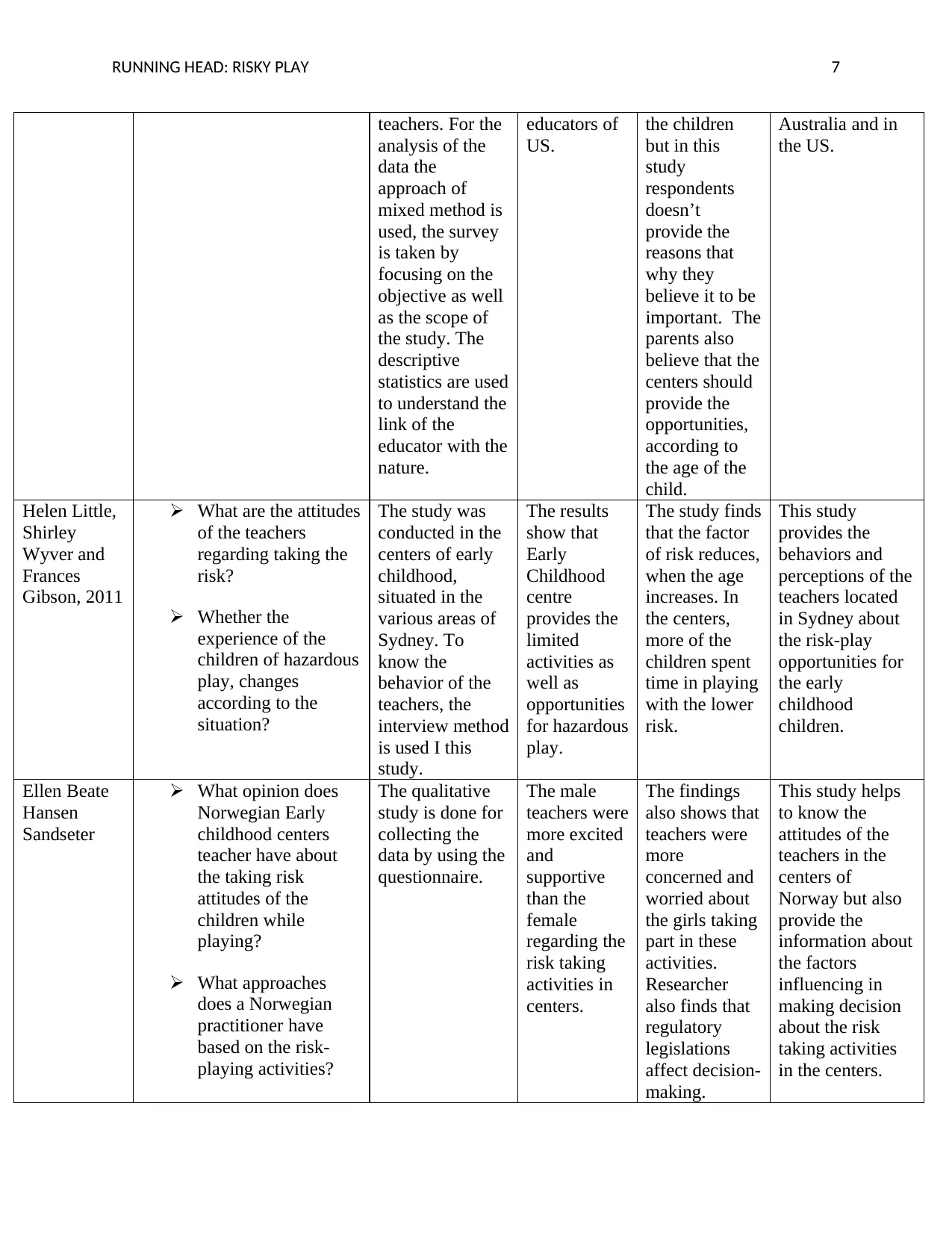
RUNNING HEAD: RISKY PLAY 7
teachers. For the
analysis of the
data the
approach of
mixed method is
used, the survey
is taken by
focusing on the
objective as well
as the scope of
the study. The
descriptive
statistics are used
to understand the
link of the
educator with the
nature.
educators of
US.
the children
but in this
study
respondents
doesn’t
provide the
reasons that
why they
believe it to be
important. The
parents also
believe that the
centers should
provide the
opportunities,
according to
the age of the
child.
Australia and in
the US.
Helen Little,
Shirley
Wyver and
Frances
Gibson, 2011
What are the attitudes
of the teachers
regarding taking the
risk?
Whether the
experience of the
children of hazardous
play, changes
according to the
situation?
The study was
conducted in the
centers of early
childhood,
situated in the
various areas of
Sydney. To
know the
behavior of the
teachers, the
interview method
is used I this
study.
The results
show that
Early
Childhood
centre
provides the
limited
activities as
well as
opportunities
for hazardous
play.
The study finds
that the factor
of risk reduces,
when the age
increases. In
the centers,
more of the
children spent
time in playing
with the lower
risk.
This study
provides the
behaviors and
perceptions of the
teachers located
in Sydney about
the risk-play
opportunities for
the early
childhood
children.
Ellen Beate
Hansen
Sandseter
What opinion does
Norwegian Early
childhood centers
teacher have about
the taking risk
attitudes of the
children while
playing?
What approaches
does a Norwegian
practitioner have
based on the risk-
playing activities?
The qualitative
study is done for
collecting the
data by using the
questionnaire.
The male
teachers were
more excited
and
supportive
than the
female
regarding the
risk taking
activities in
centers.
The findings
also shows that
teachers were
more
concerned and
worried about
the girls taking
part in these
activities.
Researcher
also finds that
regulatory
legislations
affect decision-
making.
This study helps
to know the
attitudes of the
teachers in the
centers of
Norway but also
provide the
information about
the factors
influencing in
making decision
about the risk
taking activities
in the centers.
teachers. For the
analysis of the
data the
approach of
mixed method is
used, the survey
is taken by
focusing on the
objective as well
as the scope of
the study. The
descriptive
statistics are used
to understand the
link of the
educator with the
nature.
educators of
US.
the children
but in this
study
respondents
doesn’t
provide the
reasons that
why they
believe it to be
important. The
parents also
believe that the
centers should
provide the
opportunities,
according to
the age of the
child.
Australia and in
the US.
Helen Little,
Shirley
Wyver and
Frances
Gibson, 2011
What are the attitudes
of the teachers
regarding taking the
risk?
Whether the
experience of the
children of hazardous
play, changes
according to the
situation?
The study was
conducted in the
centers of early
childhood,
situated in the
various areas of
Sydney. To
know the
behavior of the
teachers, the
interview method
is used I this
study.
The results
show that
Early
Childhood
centre
provides the
limited
activities as
well as
opportunities
for hazardous
play.
The study finds
that the factor
of risk reduces,
when the age
increases. In
the centers,
more of the
children spent
time in playing
with the lower
risk.
This study
provides the
behaviors and
perceptions of the
teachers located
in Sydney about
the risk-play
opportunities for
the early
childhood
children.
Ellen Beate
Hansen
Sandseter
What opinion does
Norwegian Early
childhood centers
teacher have about
the taking risk
attitudes of the
children while
playing?
What approaches
does a Norwegian
practitioner have
based on the risk-
playing activities?
The qualitative
study is done for
collecting the
data by using the
questionnaire.
The male
teachers were
more excited
and
supportive
than the
female
regarding the
risk taking
activities in
centers.
The findings
also shows that
teachers were
more
concerned and
worried about
the girls taking
part in these
activities.
Researcher
also finds that
regulatory
legislations
affect decision-
making.
This study helps
to know the
attitudes of the
teachers in the
centers of
Norway but also
provide the
information about
the factors
influencing in
making decision
about the risk
taking activities
in the centers.
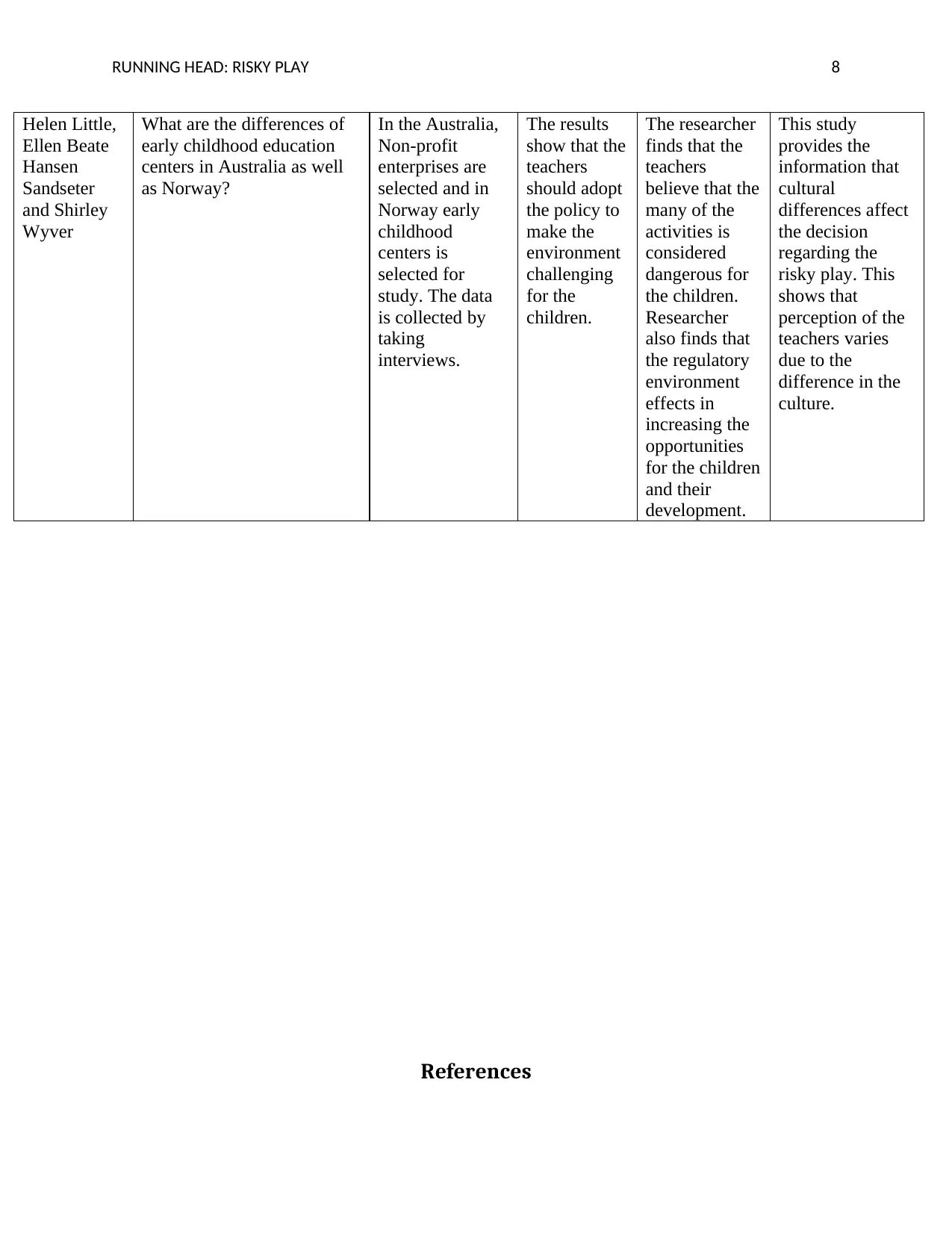
RUNNING HEAD: RISKY PLAY 8
Helen Little,
Ellen Beate
Hansen
Sandseter
and Shirley
Wyver
What are the differences of
early childhood education
centers in Australia as well
as Norway?
In the Australia,
Non-profit
enterprises are
selected and in
Norway early
childhood
centers is
selected for
study. The data
is collected by
taking
interviews.
The results
show that the
teachers
should adopt
the policy to
make the
environment
challenging
for the
children.
The researcher
finds that the
teachers
believe that the
many of the
activities is
considered
dangerous for
the children.
Researcher
also finds that
the regulatory
environment
effects in
increasing the
opportunities
for the children
and their
development.
This study
provides the
information that
cultural
differences affect
the decision
regarding the
risky play. This
shows that
perception of the
teachers varies
due to the
difference in the
culture.
References
Helen Little,
Ellen Beate
Hansen
Sandseter
and Shirley
Wyver
What are the differences of
early childhood education
centers in Australia as well
as Norway?
In the Australia,
Non-profit
enterprises are
selected and in
Norway early
childhood
centers is
selected for
study. The data
is collected by
taking
interviews.
The results
show that the
teachers
should adopt
the policy to
make the
environment
challenging
for the
children.
The researcher
finds that the
teachers
believe that the
many of the
activities is
considered
dangerous for
the children.
Researcher
also finds that
the regulatory
environment
effects in
increasing the
opportunities
for the children
and their
development.
This study
provides the
information that
cultural
differences affect
the decision
regarding the
risky play. This
shows that
perception of the
teachers varies
due to the
difference in the
culture.
References
⊘ This is a preview!⊘
Do you want full access?
Subscribe today to unlock all pages.

Trusted by 1+ million students worldwide
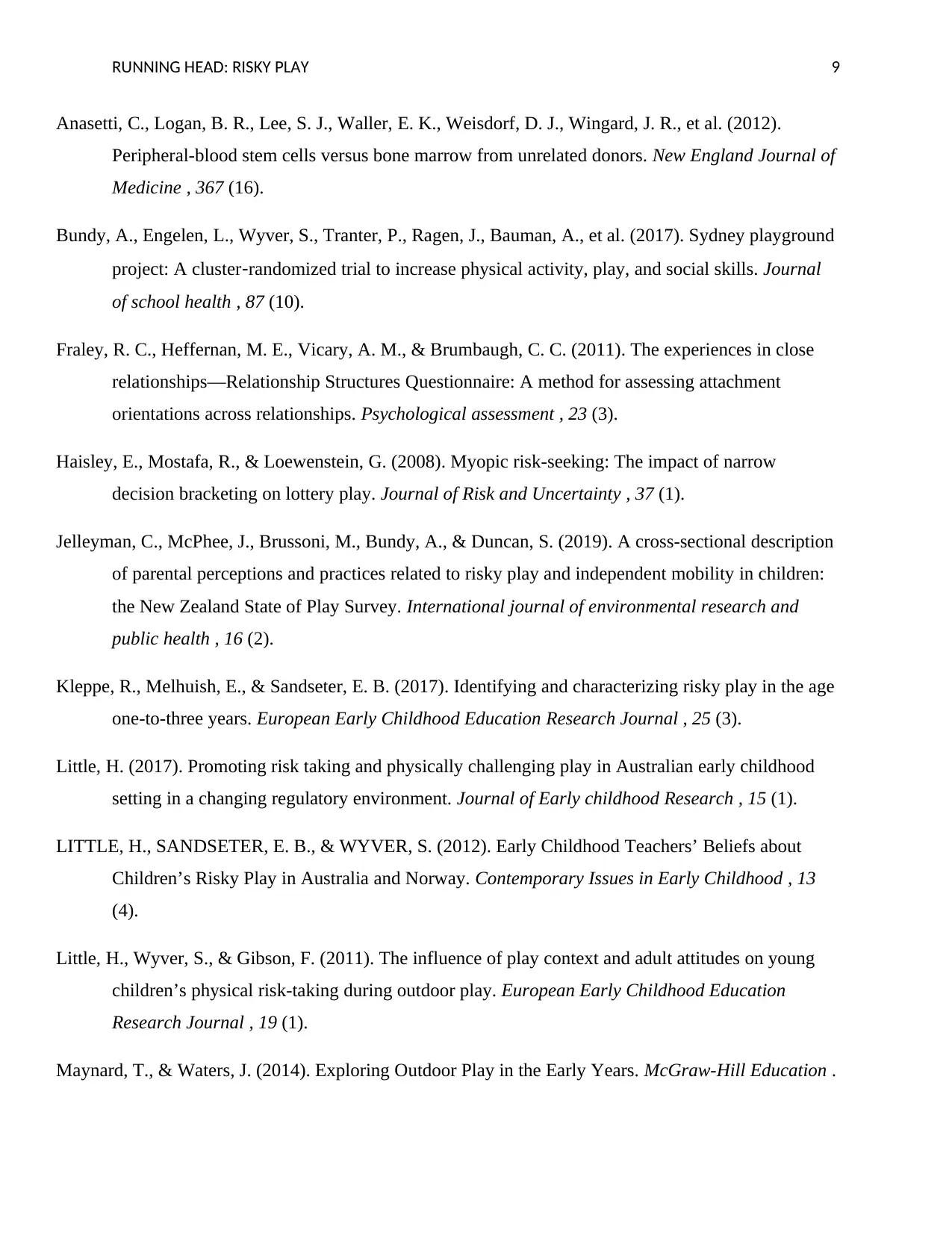
RUNNING HEAD: RISKY PLAY 9
Anasetti, C., Logan, B. R., Lee, S. J., Waller, E. K., Weisdorf, D. J., Wingard, J. R., et al. (2012).
Peripheral-blood stem cells versus bone marrow from unrelated donors. New England Journal of
Medicine , 367 (16).
Bundy, A., Engelen, L., Wyver, S., Tranter, P., Ragen, J., Bauman, A., et al. (2017). Sydney playground
project: A cluster‐randomized trial to increase physical activity, play, and social skills. Journal
of school health , 87 (10).
Fraley, R. C., Heffernan, M. E., Vicary, A. M., & Brumbaugh, C. C. (2011). The experiences in close
relationships—Relationship Structures Questionnaire: A method for assessing attachment
orientations across relationships. Psychological assessment , 23 (3).
Haisley, E., Mostafa, R., & Loewenstein, G. (2008). Myopic risk-seeking: The impact of narrow
decision bracketing on lottery play. Journal of Risk and Uncertainty , 37 (1).
Jelleyman, C., McPhee, J., Brussoni, M., Bundy, A., & Duncan, S. (2019). A cross-sectional description
of parental perceptions and practices related to risky play and independent mobility in children:
the New Zealand State of Play Survey. International journal of environmental research and
public health , 16 (2).
Kleppe, R., Melhuish, E., & Sandseter, E. B. (2017). Identifying and characterizing risky play in the age
one-to-three years. European Early Childhood Education Research Journal , 25 (3).
Little, H. (2017). Promoting risk taking and physically challenging play in Australian early childhood
setting in a changing regulatory environment. Journal of Early childhood Research , 15 (1).
LITTLE, H., SANDSETER, E. B., & WYVER, S. (2012). Early Childhood Teachers’ Beliefs about
Children’s Risky Play in Australia and Norway. Contemporary Issues in Early Childhood , 13
(4).
Little, H., Wyver, S., & Gibson, F. (2011). The influence of play context and adult attitudes on young
children’s physical risk-taking during outdoor play. European Early Childhood Education
Research Journal , 19 (1).
Maynard, T., & Waters, J. (2014). Exploring Outdoor Play in the Early Years. McGraw-Hill Education .
Anasetti, C., Logan, B. R., Lee, S. J., Waller, E. K., Weisdorf, D. J., Wingard, J. R., et al. (2012).
Peripheral-blood stem cells versus bone marrow from unrelated donors. New England Journal of
Medicine , 367 (16).
Bundy, A., Engelen, L., Wyver, S., Tranter, P., Ragen, J., Bauman, A., et al. (2017). Sydney playground
project: A cluster‐randomized trial to increase physical activity, play, and social skills. Journal
of school health , 87 (10).
Fraley, R. C., Heffernan, M. E., Vicary, A. M., & Brumbaugh, C. C. (2011). The experiences in close
relationships—Relationship Structures Questionnaire: A method for assessing attachment
orientations across relationships. Psychological assessment , 23 (3).
Haisley, E., Mostafa, R., & Loewenstein, G. (2008). Myopic risk-seeking: The impact of narrow
decision bracketing on lottery play. Journal of Risk and Uncertainty , 37 (1).
Jelleyman, C., McPhee, J., Brussoni, M., Bundy, A., & Duncan, S. (2019). A cross-sectional description
of parental perceptions and practices related to risky play and independent mobility in children:
the New Zealand State of Play Survey. International journal of environmental research and
public health , 16 (2).
Kleppe, R., Melhuish, E., & Sandseter, E. B. (2017). Identifying and characterizing risky play in the age
one-to-three years. European Early Childhood Education Research Journal , 25 (3).
Little, H. (2017). Promoting risk taking and physically challenging play in Australian early childhood
setting in a changing regulatory environment. Journal of Early childhood Research , 15 (1).
LITTLE, H., SANDSETER, E. B., & WYVER, S. (2012). Early Childhood Teachers’ Beliefs about
Children’s Risky Play in Australia and Norway. Contemporary Issues in Early Childhood , 13
(4).
Little, H., Wyver, S., & Gibson, F. (2011). The influence of play context and adult attitudes on young
children’s physical risk-taking during outdoor play. European Early Childhood Education
Research Journal , 19 (1).
Maynard, T., & Waters, J. (2014). Exploring Outdoor Play in the Early Years. McGraw-Hill Education .
Paraphrase This Document
Need a fresh take? Get an instant paraphrase of this document with our AI Paraphraser
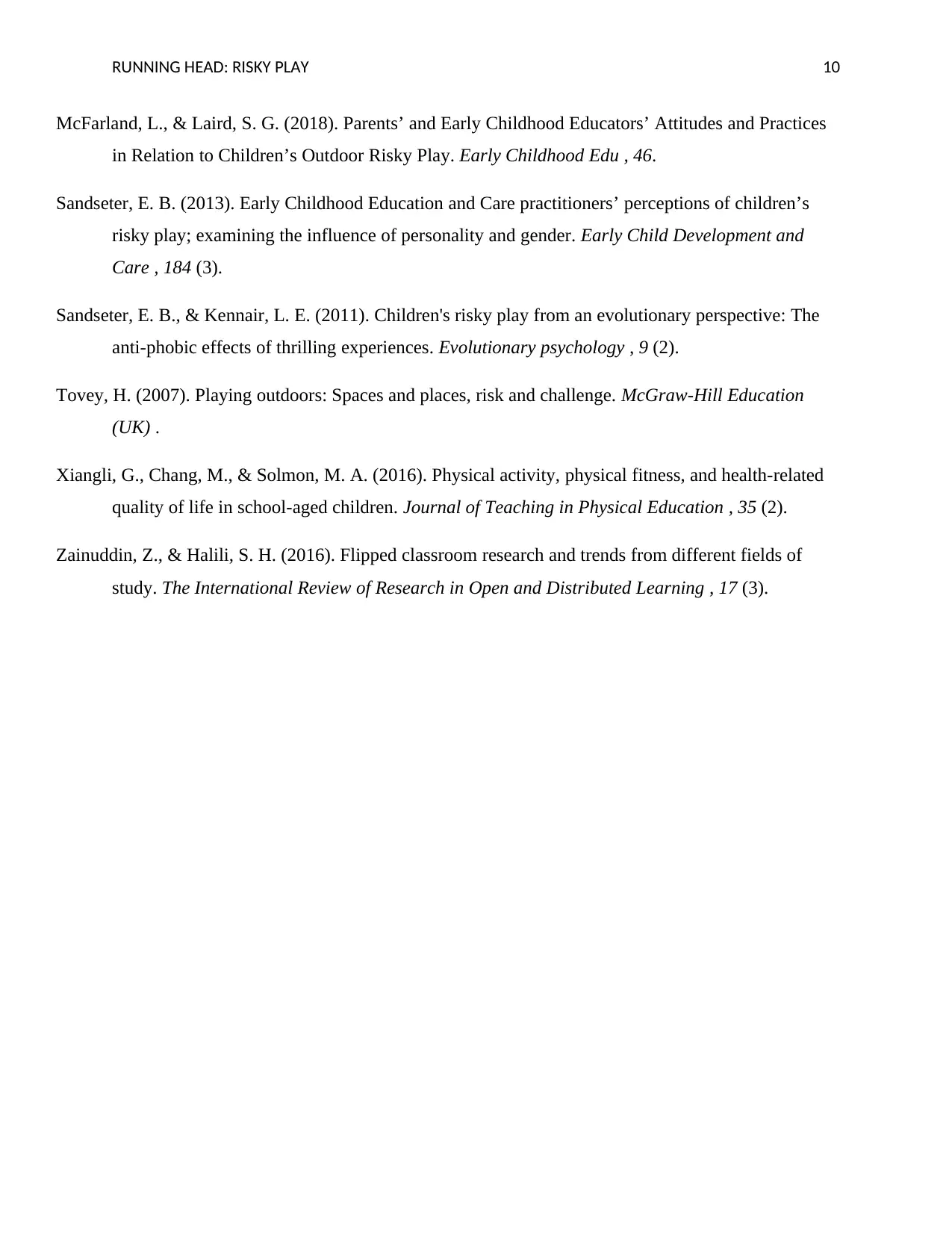
RUNNING HEAD: RISKY PLAY 10
McFarland, L., & Laird, S. G. (2018). Parents’ and Early Childhood Educators’ Attitudes and Practices
in Relation to Children’s Outdoor Risky Play. Early Childhood Edu , 46.
Sandseter, E. B. (2013). Early Childhood Education and Care practitioners’ perceptions of children’s
risky play; examining the influence of personality and gender. Early Child Development and
Care , 184 (3).
Sandseter, E. B., & Kennair, L. E. (2011). Children's risky play from an evolutionary perspective: The
anti-phobic effects of thrilling experiences. Evolutionary psychology , 9 (2).
Tovey, H. (2007). Playing outdoors: Spaces and places, risk and challenge. McGraw-Hill Education
(UK) .
Xiangli, G., Chang, M., & Solmon, M. A. (2016). Physical activity, physical fitness, and health-related
quality of life in school-aged children. Journal of Teaching in Physical Education , 35 (2).
Zainuddin, Z., & Halili, S. H. (2016). Flipped classroom research and trends from different fields of
study. The International Review of Research in Open and Distributed Learning , 17 (3).
McFarland, L., & Laird, S. G. (2018). Parents’ and Early Childhood Educators’ Attitudes and Practices
in Relation to Children’s Outdoor Risky Play. Early Childhood Edu , 46.
Sandseter, E. B. (2013). Early Childhood Education and Care practitioners’ perceptions of children’s
risky play; examining the influence of personality and gender. Early Child Development and
Care , 184 (3).
Sandseter, E. B., & Kennair, L. E. (2011). Children's risky play from an evolutionary perspective: The
anti-phobic effects of thrilling experiences. Evolutionary psychology , 9 (2).
Tovey, H. (2007). Playing outdoors: Spaces and places, risk and challenge. McGraw-Hill Education
(UK) .
Xiangli, G., Chang, M., & Solmon, M. A. (2016). Physical activity, physical fitness, and health-related
quality of life in school-aged children. Journal of Teaching in Physical Education , 35 (2).
Zainuddin, Z., & Halili, S. H. (2016). Flipped classroom research and trends from different fields of
study. The International Review of Research in Open and Distributed Learning , 17 (3).
1 out of 11
Related Documents
Your All-in-One AI-Powered Toolkit for Academic Success.
+13062052269
info@desklib.com
Available 24*7 on WhatsApp / Email
![[object Object]](/_next/static/media/star-bottom.7253800d.svg)
Unlock your academic potential
Copyright © 2020–2025 A2Z Services. All Rights Reserved. Developed and managed by ZUCOL.





